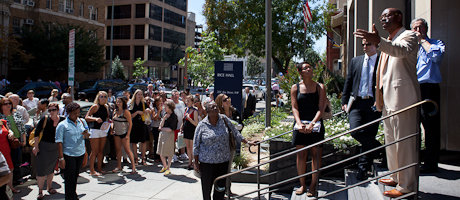Associate Professor of Civil and Environmental Engineering Pedro Silva is an earthquake expert, but the 5.9-magnitude quake that rocked the East Coast Tuesday still caught him somewhat by surprise.
Dr. Silva, whose specialty is designing buildings to be more earthquake resistant, was in his office in the Academic Center when the ground began to shake Tuesday. He said it took him a few seconds to recognize what was going on. “It was very unusual for this area,” he said.
George Washington Today had the opportunity to ask him about the earthquake, its magnitude and predictions for the future.
Q: Was Tuesday’s earthquake unprecedented for the Washington area? What caused it?
A: This was a very rare event; the magnitude was among the highest recorded in the region. It was an intraplate earthquake, which occurred in the interior of the North American tectonic plate. Intraplate earthquakes are far less frequent than earthquakes that occur at the plate boundaries.
Q: There was a 3.6-magnitude earthquake last year in the region. Is there any pattern to them? Should we expect more?
A: If there is a pattern, scientists haven’t figured it out yet, but a major earthquake—around 6.0—has been expected in the region for some time. The fact that it has happened now makes it more likely that there won’t be another in the next decade since this earthquake has at least temporarily alleviated stresses.
Q: Where can we expect more earthquakes?
A: In the U.S. the “hot spots” include the West Coast, Utah, along the New Madrid fault line in the Midwest, and in Charleston, S.C. In Charleston in 1886, there was an earthquake with a magnitude of 7.3 on the Richter scale and a recorded intensity of 10.0 in the Mercalli intensity scale. That earthquake killed dozens of people. Across the world, areas of high risk include Iran, the island of Japan, the Caribbean islands, North Africa and along the west coast of South America.
Q: Tuesday’s earthquake was felt from North Carolina to Massachusetts. Is this widespread of an area of impact typical?
A: In this region, because of the brittle nature of the bedrock, the rate of dissipation/attenuation is much smaller than in many other regions. In California, for example, an earthquake’s strong motion effects are usually felt over much smaller distances from within the epicenter. In contrast, this magnitude of an earthquake happens much more frequently in California.
In Tuesday’s earthquake, the effects were felt over a very wide region, which in the case of the West Coast would be unthinkable. The earthquake here was felt within seconds in D.C., New York, Boston, North Carolina and West Virginia. On the West Coast this would be very unlikely if nearly impossible.
Q: What about earthquakes’ aftershocks? When can we expect them, and how strong are they?
A: Typically, the stronger aftershocks occur within the first 24 hours. In the first few hours after the earthquake, there were several aftershocks, but their magnitude was low enough that most people did not feel them.
Q: What safety measures can people take during earthquakes?
A: Stay away from bookshelves or anything heavy that could fall, and do not move to the middle of a room. If possible, stay near a door jamb, brace yourself in a door jamb, or find a sturdy desk and get underneath it. Wait a minute before exiting a building to ensure there’s not any harmful debris falling from the facades of the buildings, such as glass or bricks. If at home, an inside bathroom or closet is best—somewhere without windows.
Q: Are there any lessons learned from this earthquake?
A: If nothing else, we should feel pretty lucky. The earthquake didn’t last long enough for much real damage to develop. It should be a warning to prepare in the future, and, as I have been saying in my classes, earthquakes do indeed happen almost anywhere even on the East Coast.


